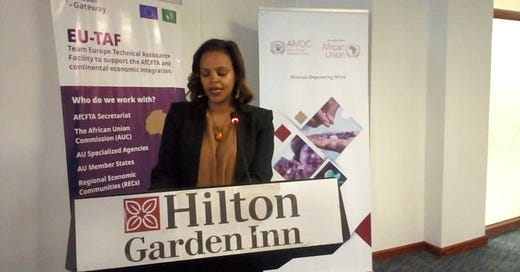African Union Urges Africa to Leverage its Mineral Wealth
Recognizing the paradox of poverty amidst abundant natural resources, African Heads of State adopted the Africa Mining Vision (AMV) at the 2009 African Union Summit.
LUSAKA, Zambia- The African Union's African Minerals Development Center (AMDC) has emphasized the need for Africa to capitalize on its vast mineral resources endowment, positioning the continent to play a central role in the energy transition context, writes Kennedy Phiri.
The demand for minerals and metals is set to rise significantly, with the world requiring six times more minerals and metals by 2040 in the push toward a net-zero future.
AMDC Interim Director, Dr. Marit Kitaw, cited lithium, nickel, cobalt, manganese, graphite, and rare earth elements as being crucial for battery performance, electric vehicles, and wind turbines.
"The production of lithium and cobalt alone may increase by 500% by 2050 to meet the demand for clean energy," Dr. Kitaw stated.
This presents Africa with an opportunity to efficiently exploit its strategic minerals and break the vicious cycle of over-reliance on exporting natural resources by creating more value on the continent, strengthening production capacities, and developing intra-African exports and trade through the African Continental Free Trade Area (AfCFTA).
"Africa wants to harness its natural resource potential to achieve sustainable economic transformation and development. It will not settle for the role of a delegated producer that exports minimally processed raw materials and ultimately clean energy," Dr. Kitaw added.
However, she lamented that Zambia, despite being endowed with mineral resources like copper, cobalt, manganese, uranium, and nickel, has over 60 percent of its population living below the poverty line.
Additionally, with over 70 percent of foreign earnings derived from copper, the country lacks diversification and is vulnerable to commodity price fluctuations.
Recognizing the paradox of poverty amidst abundant natural resources, African Heads of State adopted the Africa Mining Vision (AMV) at the 2009 African Union Summit.
The AMDC was established as the coordinating arm for the African Union Commission to implement the AMV and ensure that minerals play a greater transformative role in the continent's development.
The AMDC aims to increase Africa's role in the mineral supply chain, ensuring that the continent fully benefits from exploration, extraction, processing, smelting, refining, alloying, manufacturing, marketing, and the final sale of its vast mineral resources.
The African Union, in collaboration with institutions like the African Development Bank, has developed an African Green Minerals Strategy, which is expected to be approved and endorsed by the Specialised Technical Committee on Trade, Industry, and Minerals in Malabo, Equatorial Guinea, in May 2024.
Zambia is one of five pilot African countries on initiatives and governance approaches in sustainable mineral resource management, aligned with the AMV principles.
The other countries are Morocco, Ghana, Gabon, and the Democratic Republic of Congo.
The European Union has expressed concern that Africa has been unable to exploit the full potential of its mineral resources, which are supposed to be real assets for its development.
However, the EU acknowledges that the adoption of the AMV has paved the way for a "responsibility regime" for the extraction of natural resources, aligning with the EU's objective of "strategic autonomy."
The assessment reports reveal that most of the five pilot countries are at an intermediate level of AMV implementation, highlighting the need for continued efforts to fully leverage Africa's mineral wealth for sustainable development.




